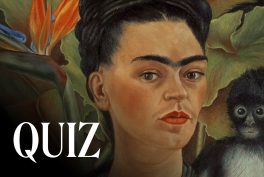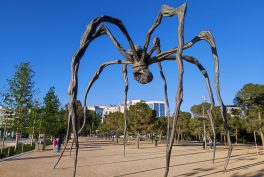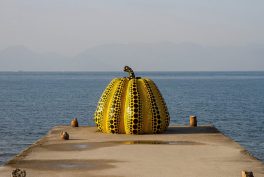Louise Bourgeois (1911–2010), a French-American artist, spent her childhood in a gallery selling antique tapestries run by her father and the tapestry renovation workshop run by her mother. Interestingly, when the time came to decide what she would study, art was not her first choice—mathematics and geometry were. She cherished the exploration of unchangeable rules and the stability of those subjects.
In 1932, after her mother’s death, she decided to study art. She had a chance to study under André Lhote, and Fernand Léger; the latter saw the sculptor in her rather than a painter. Despite that, throughout her career Bourgeois was always pursuing a variety of art forms. She was always a free spirit; while she may associate with some of the art movements of the time, she would never fully align with them, pursuing her own path.
1. Femme Maison, 1946–1947
It is one of the paintings in the Femme Maison series that Bourgeois created in 1946-1947. They touch on the topic of female identity and social expectations, but also the visibility and experience of being watched. The series title translates from the French as “housewife”: literally, “woman house.”
We can only guess whether the woman is trying to hide within the house, or if she is being imprisoned there. Is the house representing the mind as an opposition to the body? Or is it protecting her privacy while her body is on display whether she wants it or not?
2. Janus Fleuri, 1968
After moving to New York with her husband in 1938, Bourgeois struggled to find her place in the art world there. The 1950s were a quiet decade for her, marked by depression after her father’s death, but in 1954 she joined the American Abstract Artists Group, and she became friends with Willem de Kooning, Mark Rothko, and Jackson Pollock. While she never fully embraced abstraction, finding kindred spirits helped her gradually build confidence.
Here we see an unmistakably organic form cast in shiny bronze. The Janus of the title is a Roman god of gates, doorways, beginnings, and endings (January the opening month of the year, is named after him) and he is often portrayed as having two heads facing in opposite directions. Here, to reflect this duality, Bourgeois merges the male and female anatomy. Fleuri means “in blossom” or “glowing,” and may refer to the shiny bronze patina, but also to the blossoming of the new merged creation.
3. Destruction of the Father, 1974
Louise Bourgeois often said that her art is a form of exorcism for her; a way to deal with past traumas. Nowhere is it more explicit than in this work. Bourgeois’ father was involved in a decade-long affair with the family’s British au pair. Louise was deeply hurt by this; she experienced the feeling of betrayal, abandonment, and the conflicting emotions of loving her father and hating him at the same time for the damage he did to the family. This push and pull is visible in the piece.
The oppressive womb-like room can be either the bedroom or the dining room. In the middle we see the latex rubber-covered casts of hunks of meat on the bone, all this bathed in a gory and suffocating red light. The whole scene looks like the aftermath of a crime or the remains of a horrific cannibalistic feast.
4. Arch of Hysteria, 1993
Louise Bourgeois was in psychoanalysis from 1951, when her father died, until the 1980s. In the early days of this discipline, there was a lot of interest in female hysteria–the psychological or mental suffering manifesting through the body. Here Bourgeois subverts the gendered association, by showing us a male body in the hysterical backbend. It is a cast of the body of her assistant Jerry Gorovoy.
5. Maman, 1999
This is by far Bourgeois’s best-known work. While spiders are typically perceived as ugly and creepy, the artist had a very different view of them.
For her, the spider was her mother, the weaver, and restorer of tapestries, the protector of the home, the endlessly patient and selfless figure. To reflect all her complex emotions for her mother Bourgeois did not hold back; the sculpture is enormous, 9.2 x 8.9 x 10.2 m (over 30 x 29 x 33 ft.) and weighs 3,658 kg. While it may seem daunting as you approach it, once you get under it, it feels oddly protective.
Louise Bourgeois’s artworks invite us into her world—one of webs, memories, and raw, honest emotion. Through just five of her works, we glimpse her lifelong journey of exploring the complexities of identity, family, trauma, and the subconscious. Her sculptures and installations are more than just objects; they are profound reflections of the human experience, woven together with both tenderness and defiance. And like her famous spiders, her creations linger—both captivating and haunting—in our minds.












